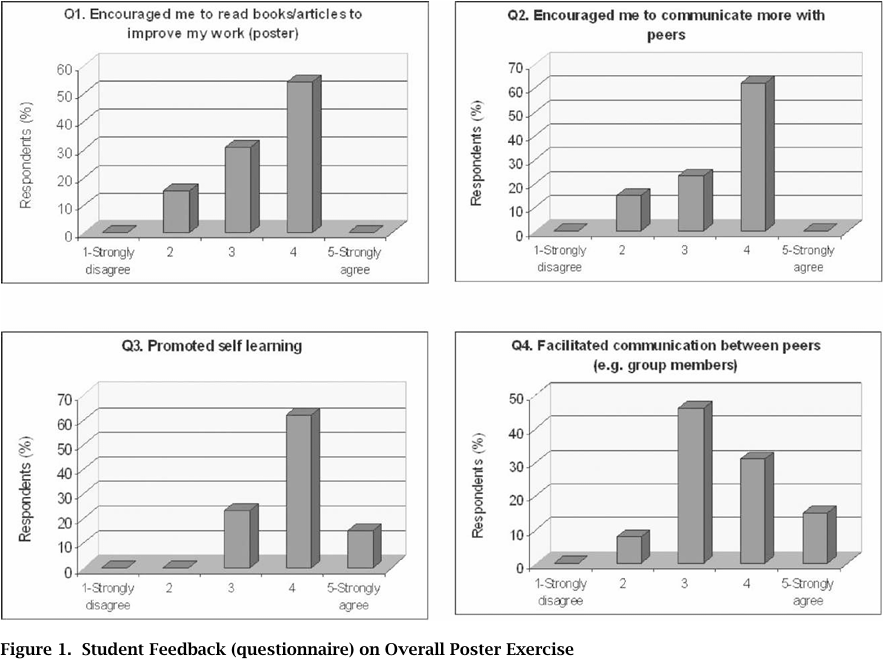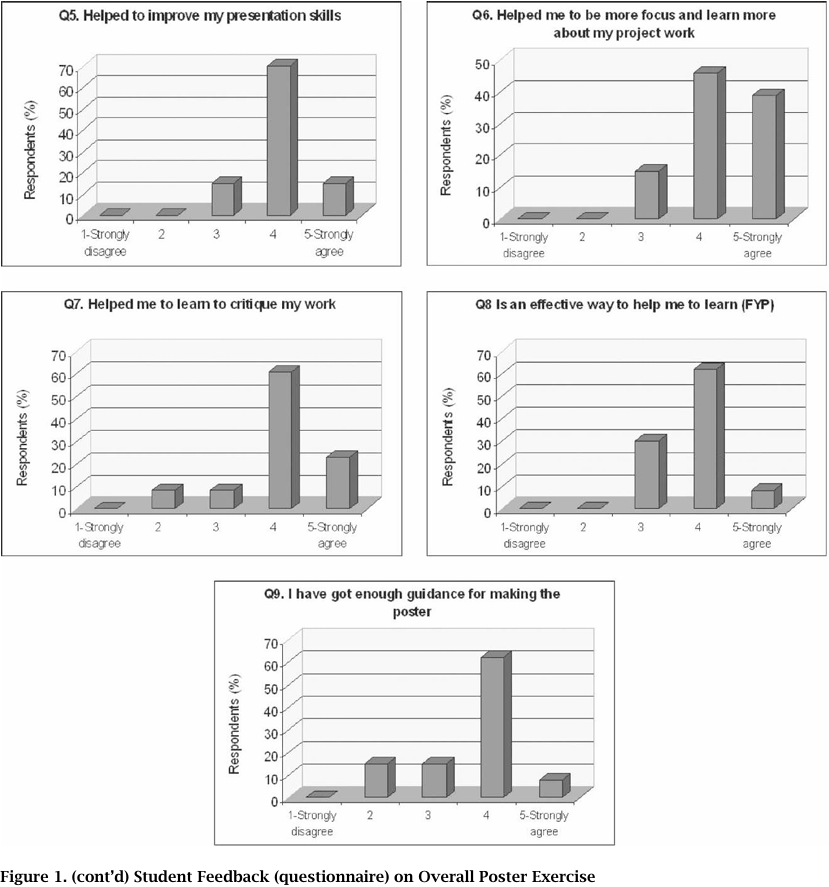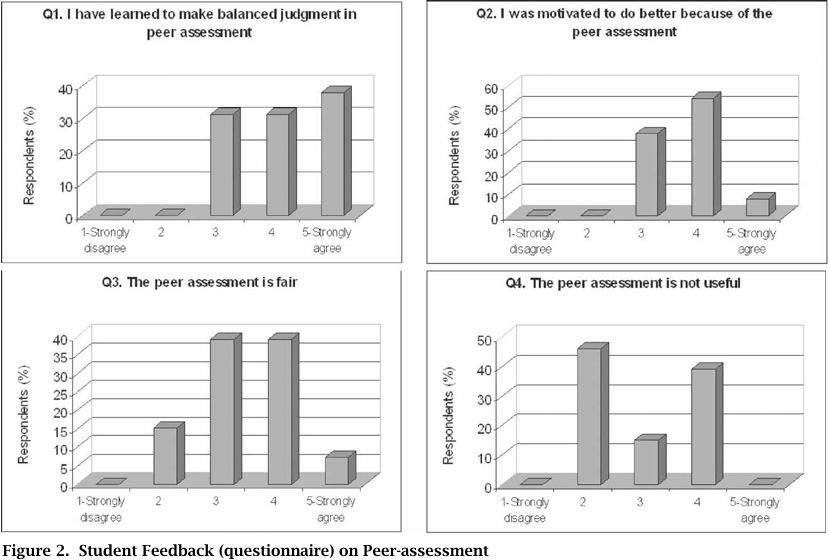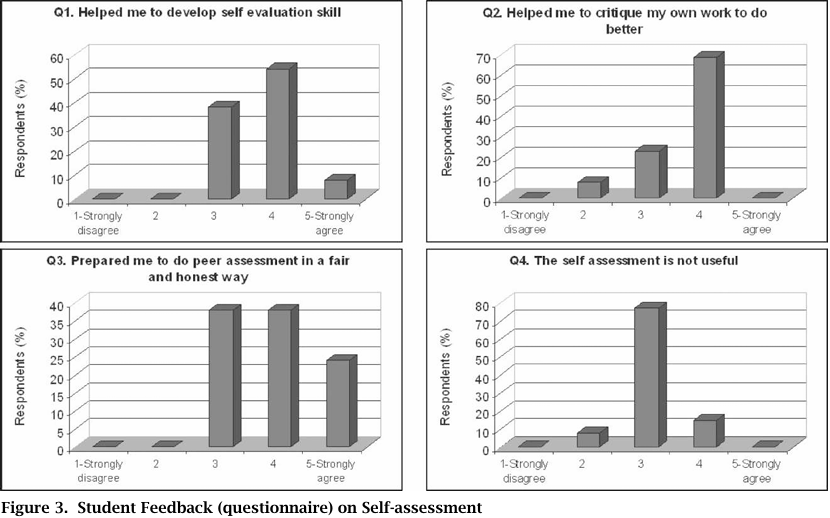
Results Questionnaire
 المؤلف:
Pauline Cho
المؤلف:
Pauline Cho
 المصدر:
Enhancing Teaching and Learning through Assessment
المصدر:
Enhancing Teaching and Learning through Assessment
 الجزء والصفحة:
P160-C15
الجزء والصفحة:
P160-C15
 2025-07-01
2025-07-01
 382
382
Results Questionnaire
The response rate to the questionnaire was 48% (13/ 27). Figures 1 - 3 present the distributions of responses to the forced choice questions.


Figure 1 presents the responses of the students to questions regarding the overall poster exercise. Over 80% of the students agreed/strongly agreed that the poster exercise helped them to improve their presentation skills, to be more focussed and to learn more from their project work, and to learn to critique their own work. About 70% of them agreed/strongly agreed that this exercise promoted self-learning and was an effective way to help them to learn. While 62% agreed/ strongly agreed that poster assessment encouraged them to communicate more with peers, only 46% agreed/ strongly agreed that the exercise facilitated communication between group members. Only about 50% of the students agreed/strongly agreed that this exercise encouraged them to read books/articles to improve their work (the poster). With regard to guidance provided for making the poster, 70% of the students agreed/strongly agreed that there was adequate guidance, but 15% disagreed.
From their responses to the open-end question on the aspects of the overall poster exercise that students liked best, students commented that the exercise allowed creativity, provided a chance to learn how to organize and present their findings, offered them a sense of achievement when their posters were exhibited at a conference co-organized by the department, and facilitated discussion among project groups. Some students also commented that the peer-assessment element allowed them to know more about how their work were being assessed, and helped them to improve their own work, and increased understanding of their own project. To improve the poster assessment exercise, students suggested a group poster instead of individual submissions, as they preferred team work and cooperation rather than "competition between members of the same group". They also found it difficult to keep their own work confidential. Some students also suggested more time to make their posters (that the posters be submitted after their final project reports instead of before). A couple of students also suggested increasing the number of awards (for the best posters), reducing the weighting for peer-assessment, and increasing feedback on the mock poster assessment exercise.
On the usefulness of poster assessment, the two students who were negative commented that the workload was too heavy and the time inadequate. They queried the fairness of peer-assessment as they felt that students did not have adequate experience to do assessment, and that guidelines provided lacked clarity and detail. The six students who gave a positive response to this question felt that poster assessment gave them a chance to learn a new method of presenting their final year project work, and provided them with another channel for presenting results other than report writing. The exercise was interesting, allowed creativity, provided an avenue for students to better understand their own projects, and helped them to learn how to critique other student's work objectively.

On peer-assessment (Figure 2), 69% of the students agreed/strongly agreed that peer assessment helped them to learn to make a balanced judgment, and 62% agreed/strong agreed that they were motivated to do better because of peer assessment. However, only 46% agreed/strongly agreed that the peer assessment was fair (39% were neutral, and 15% disagreed). Only 46% of the students agreed that peer assessment was useful (39% did not find it useful, and the rest were neutral).
On the aspects of peer-assessment that they liked best, students appreciated that in peer-assessment, they learned from each other and shared experience. They were given a fair method of assessment with a useful set of assessment criteria. On the aspects that they found lacking, a couple of students suggested that a more detailed marking scheme and guidelines should be provided. Two students also commented on the difficulty of not letting other students know about their posters. Other suggestions included increasing the scale used to rate the poster, allowing peer-assessment between close friends, and assessment of posters of the same group for better comparison, and a group poster to 'increase fairness', and to reduce the number of posters assessed by each student.
The responses of the students to questions on self-assessment are presented in Figure 3. Over 60% of the students found that it helped them to develop self-evaluation skills (62%), helped them to critique their own work to do better (69%), and prepared them to do peer assessment in a fair and honest way (62%). Only 15% of the students found self-assessment not useful, while the majority were neutral (77%).
In their responses to the open-ended question on aspects that they liked about self-assessment, students commented that self-assessment allowed them to recognize their own weaknesses better, allowed them to better understand their project work, and that it was simple and easy to do. There were also comments that the detailed assessment checklist given and self-assessment conducted before peer-assessment allowed them to have a better understanding of the assessment. On the negative side, students commented on the difficulty of doing self-assessment as it was hard for them to eliminate their bias and to discover their own mistakes. One student also commented that self-assessment was not as useful as peer-assessment.

 الاكثر قراءة في Teaching Strategies
الاكثر قراءة في Teaching Strategies
 اخر الاخبار
اخر الاخبار
اخبار العتبة العباسية المقدسة


